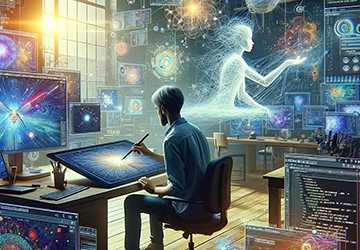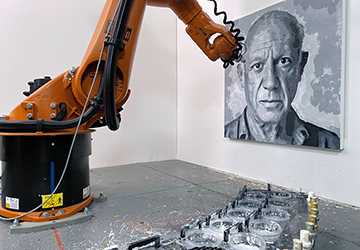Art and Technology Converge Ushering in a New Creative Era
The symbiosis of art and technology has ushered in an unprecedented creative era, changing the paradigm of art creation, dissemination, and experiential engagement. This convergence has produced transformative innovations that have combined the traditional and digital art worlds.

The Evolution of Technology in the Art World
The introduction of technology into the art world has triggered a paradigm shift in artistic methodology. From digital illustration to immersive virtual reality experiences, technology has provided artists with tools with unprecedented potential.
- Digital illustration software enables limitless creativity that is unconstrained by human materials.
- Augmented reality (AR) and virtual reality (VR) enable immersive experiences and bring art to life in unprecedented dimensions.
- Distributed ledger technology provides an impenetrable paradigm for verifying and monetizing digital art and protecting creators' privileges.
Digital Art Technology: Tools and Platforms
The rise of digital art technology has created many sophisticated tools and platforms that enable artists to create complex digital masterpieces with global impact.
- Drawing tablets and pens simulate the tactile feel of traditional painting, providing precision and control.
- Advanced software such as Adobe Creative Suite, Corel Painter, and Procreate offer digital artists a wide range of capabilities.
- Online platforms such as DeviantArt, Behance, and ArtStation enable artists to showcase their work to a global audience and gain recognition and opportunities.
The Future of Collaboration Between Art and Technology
If one imagines the future of collaboration between art and technology, the future holds promise for more innovation. As technology advances, it will continue to enhance artistic expression and expand the boundaries of creativity.
- Artificial Intelligence (AI) can examine and generate artistic creations, providing visual art connoisseurs and practitioners with unparalleled perspectives and approaches.
- Machine learning algorithms help artists explore new styles and modes and push the boundaries of their creativity.
- Interactive installations and multimedia performances blend physical and digital art to create unique and exciting experiences.
A Bridge Between Cultures and Communities
The future of collaboration between art and technology has the potential to connect cultures and communities and promote a better understanding and appreciation of different forms of artistic expression.
- Virtual reality exhibitions allow people in different parts of the world to experience art from other cultures.
- Collaborative online platforms allow artists from different backgrounds to work together and blend their unique styles and perspectives.
- Technological advances can preserve and disseminate cultural heritage and ensure that traditional artistic expressions survive and thrive in the contemporary digital age.
The Power of Distributed Ledger Technology
The future of collaboration between art and technology offers solutions to some of the most pressing issues in digital art.
- NFTs (non-fungible tokens) provide a mechanism to verify the authenticity and ownership of digital art.
- Blockchain ensures that transactions are transparent and secure, protecting artists' intellectual property.
- Decentralized platforms enable artists to bypass traditional gatekeepers and access global markets.
The Impact of Technology in the Art World on Art Education
The effect of technology on the art world also extends to art education, providing students with new ways to learn about and engage with art.
- Online courses and tutorials democratize art education, making it accessible to anyone, anywhere.
- Virtual art classes and workshops allow students to learn from outstanding artists and teachers worldwide.
- Learning software and apps provide interactive courses that improve the learning experience.
Digital Art Technology and Accessibility
The democratization of art allows more people to participate in and appreciate artistic endeavours.
- Social media platforms like Instagram and Pinterest allow artists to share their work with a broad audience and receive instant feedback and recognition.
- Online galleries and virtual exhibitions provide artists a platform to showcase their work without needing a physical space.
- Digital tools enable disabled artists to create art while overcoming physical limitations.
Digital Art Technologies: Catalysts for Creative Innovation
Digital art technologies promote creative innovation and push the boundaries of artistic possibilities.
- Interactive art installations that respond to viewer movements and input create dynamic and engaging experiences.
- Generative art created using algorithms and artificial intelligence introduces novel forms of artistic expression.
- Digital sculpting and 3D printing enable the creation of complex artworks that were previously unattainable.

Challenges and Opportunities of Technology in the Art World
Integrating technology into art is both a challenge and an opportunity for artists and the industry.
- Rapid technological advancement requires constantly updating skills and adaptation to new tools.
- Intellectual property issues and digital piracy pose significant challenges and require a solid legal framework.
- However, technology also provides unprecedented opportunities for innovation, collaboration, and audience expansion.
Virtual Reality and Augmented Reality: Transformative Tools in the Arts
It provides artists with immersive, interactive media that revolutionize traditional art practices.
- VR allows artists to create and manipulate art in a three-dimensional virtual environment, providing unrestricted creative freedom.
- AR overlays digital elements onto the human world, allowing artists to blend real and virtual imagery seamlessly seamlessly.
- These technologies enable unprecedented interactive exhibitions where audiences can interact with art in an immersive environment, evoking a multi-sensory experience.
The Intersection of Art, Technology and Culture
The future of collaboration between art and technology is closely tied to cultural expression, enabling novel storytelling and heritage preservation forms.
- Digital ethnography: using digital tools to document and preserve cultural practices and traditions and ensure they are accessible to future generations.
- Transmedia storytelling: integrating multiple digital platforms to tell complex, multi-layered stories beyond traditional narratives.
- Virtual museums: creating immersive online museum experiences that allow global audiences to explore cultural artefacts and exhibits beyond geographic boundaries.
The Role of Technology in Collaborative Art Projects
Technology has enabled unprecedented artistic collaboration, allowing artists from all backgrounds to create and innovate.
- Cloud-based studios enable artists to collaborate in real-time, regardless of geographic location, promoting global collaboration.
- Collaborative blockchains ensure transparent and secure collaboration, track contributions and ensure fair distribution of profits.
- VR Collaboration: This technology enables artists to collaborate in a shared virtual environment and innovatively combine their skills and perspectives.
Conclusion
The intersection of art and technology marks the beginning of a new creative era, where technology in the art world, digital art technology, and the future of collaboration between art and technology are reshaping the landscape of artistic expression. As we continue to explore this exciting convergence, the opportunities for innovation, collaboration, and cultural exchange are endless. This new era expands how we create and experience art and democratizes access to art to ensure that all can appreciate and enjoy art.